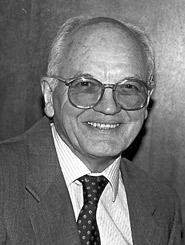Berkeleyan
Obituary
Chester O'Konski
![]()
30 August 2006
 |
Chester T. O'Konski, a professor emeritus of chemistry who was one of the first chemists to study nucleic acids and proteins using physical chemistry methods, died at his home in El Cerrito on Aug. 2. He was 85.
In his 43 years on the faculty of the Department of Chemistry, O'Konski employed many different methods to study the properties of large molecules.
"He was among the first physical and polymer chemists to apply high electric fields to solutions of biological materials [in order to study] the asymmetric properties resulting from the field," said John Hearst, professor emeritus of chemistry. The technique allowed examination of molecules as they existed in their natural state in solution, and it yielded new information about the size, structure, and optical and physical properties of molecules.
A pioneer in the use of nuclear quadrupole spectroscopy, a technique used to examine how nuclei in the atoms of a molecule react to chemical bonding, O'Konski also worked out theoretical calculations on the chemical bonding of molecules. "He did so many different things that one would really have to look at his publication list to review them all," said Rollie Myers, professor emeritus of chemistry.
O'Konski was born on May 12, 1921, on his parents' dairy farm in Kewaunee, Wis. As an undergraduate he attended the University of Wisconsin at Madison. After obtaining a B.S. in chemistry in 1942, he worked with a top-secret team on a Panamanian island in 1944, helping to develop gas-mask technology. As a result of this work, O'Konski was instrumental in designing one of the first aerosol particle counters, according to his son, Tim O'Konski.
In 1946, O'Konski received an M.S. in physical chemistry from Northwestern University. Two years later - a year before Northwestern granted him his Ph.D. in physical chemistry - he was hired as an instructor in the chemistry department at Berkeley. "Chester was the second biophysical chemist to be hired in the department," Myers said. "He arrived just a year or two after Bruno Zimm, who was the first. Before Bruno moved to UC San Diego, the two of them published several papers together."
In 1950, after two years as an instructor, O'Konski became an assistant professor, then was made a full professor in 1960. He remained with the chemistry department until his retirement in 1991.
His early work in the optical properties of biological molecules - particularly the tobacco mosaic virus - won O'Konski a number of awards. In 1955 he received a Guggenheim fellowship to Leiden University in the Netherlands. In 1960 he held the chemistry department's Miller Professorship (with the Miller Institute for Basic Research in Science). And in 1970 he was named a Nobel guest professor at Upsalla University in Sweden.
Citing O'Konski's research demonstrating the feasibility of using electric-field-induced double refraction ("birefringence") to study the electrical properties and structures of macromolecules in solution, the International Committee for Molecular Electro-optics awarded him the Kerr Medal in 1991.
O'Konski is survived by his daughter, Holly Austin, of Crescent City; his three sons, Tim of Palo Alto, Mark of Fort Myers, Fla., and Brian of Washington, D.C.; and five grandchildren.
Memorial contributions may be made to the UC Berkeley Foundation with a notation "in memory of Chester O'Konski" and sent to the College of Chemistry, c/o Jane Scheiber, Assistant Dean, University of California, Berkeley, CA 94720-1460.
- Liese Greensfelder

